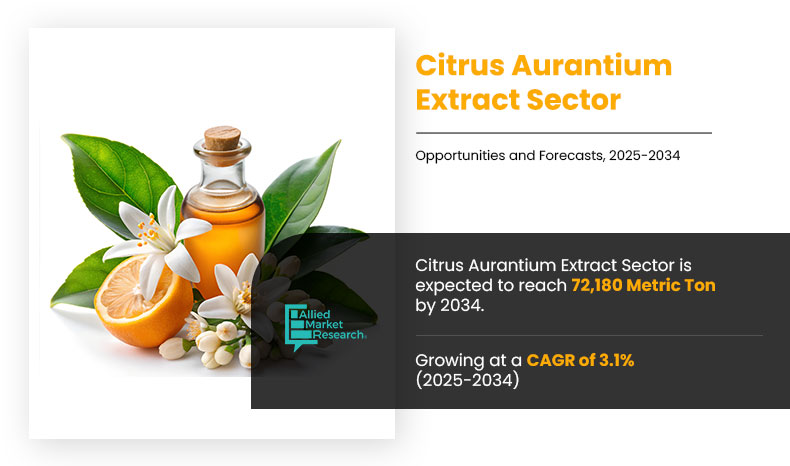Volume Insights on Citrus Aurantium Extract Sector
The global citrus aurantium extract sector volume projection was valued at 53,340 metric ton in 2024 and is projected to reach 72,180 metric ton by 2034, registering a CAGR of 3.1% from 2025 to 2034.

Volume Insights Strategic Overview
Allied Market Research announces the release of its comprehensive analysis of global shipments of citrus aurantium extract. Citrus aurantium extract offers thermogenic properties for weight management, appetite control benefits, astringent and antioxidant effects in cosmetics, and bold citrus flavor enhancement in beverages and snacks, supporting diverse applications across dietary supplements, personal care, and functional food formulations.
The report highlights increase in demand for citrus aurantium extract, driven by rise in consumer preference for clean-label and plant-based products, expanding use of natural weight management ingredients, and growing interest in botanical compounds in cosmetic and personal care formulations. Food and beverage manufacturers have made utilization of citrus aurantium extract for bold citrus flavor and metabolism-supporting properties. Supplement producers rely on citrus aurantium extract for thermogenic effects and appetite control. Technological advancements in extraction techniques have improved purity and formulation stability, encouraging use of citrus aurantium extract across dietary supplements, beverages, snacks, and plant-based cosmetic applications.
The steady growth in shipments is attributed to an increase in demand for plant-based supplements, wider adoption in natural cosmetic formulations, and rise in use of citrus flavoring functional beverages and clean-label food products. The global citrus aurantium extract sector volume projection is expected to grow from 53,340 metric ton in 2024 to 72,180 metric ton by 2034, registering a CAGR of 3.1% during the forecast period. This expansion of citrus aurantium extract sector sales is driven by rise in formulation flexibility, improved extract stability in diverse product matrices, rising awareness of botanical sourcing transparency, and integration of citrus aurantium extract into niche wellness, sports nutrition, and cosmetic segments.
Regional Citrus Aurantium Extract Sector Volume Growth
North America dominated the citrus aurantium extract sector with 43.7% share in 2024 and a 2.5% CAGR, while Europe, Asia-Pacific, and LAMEA show strong growth at 2.7%, 4.9%, and 3.4% CAGR, respectively, driven by increase in targeted product innovation, regulatory clarity for natural stimulants, and expanding distribution through specialty wellness retailers, and evolving consumer preferences across regions.
The regional analysis highlights significant variations in adoption trends and sector potential across the globe. North America leads the sector, accounting for over 43.7% of total volume in 2024 and is projected to grow at a CAGR of 2.5%. Growth is supported by rise in demand for natural weight management supplements, high consumer acceptance of clean-label nutraceuticals, and active product development focused on energy and metabolism support. Europe, led by Germany and the UK, is expected to maintain a 2.7% CAGR during the forecast period, driven by preference for botanical ingredients in functional foods and supplements, regulatory support for plant-based formulations, and rise in awareness of cardiovascular health. Asia-Pacific, with key countries such as China, Japan, and India, is anticipated to expand at a 4.9% CAGR due to rise in health-conscious middle class, increase in popularity of traditional botanical remedies, and broader use of citrus-based ingredients across food and personal care categories. Meanwhile, LAMEA is projected to grow at a 3.4% CAGR, fueled by expanding wellness trends, increased use of plant-based ingredients in regional dietary supplements, and growing interest in locally sourced citrus-derived products in countries such as Brazil, South Africa, and the Middle East.
Citrus Aurantium Extract Sector Volume Growth, By Region, 2024-2034 (Metric Ton)
Region | 2024 | 2028 | 2034 | CAGR (2025–2034) |
North America | 23,330 | 25,370 | 29,750 | 2.5% |
Europe | 15,190 | 16,640 | 19,730 | 2.7% |
Asia-Pacific | 10,350 | 12,340 | 16,540 | 4.9% |
LAMEA | 4,470 | 5,010 | 6,150 | 3.4% |
Total | 53,340 | 59,360 | 72,170 | 3.1% |
Source: AMR Analysis
Citrus Aurantium Extract Country Sector Sales
U.S. and Germany lead the citrus aurantium extract sector volume share, with projections reaching 26,200 metric ton and 5,760 metric ton by 2034, growing at a CAGR of 2.4% and 2.1%, respectively. Meanwhile, Singapore (6.5% CAGR) and Australia (5.9% CAGR) are emerging as high-growth countries for citrus aurantium extract, driven by increase in consumer demand for natural ingredients in weight management and energy-boosting products. Consumers in these countries are seeking clean-label, plant-based solutions that offer functional benefits without synthetic additives. In addition, the expansion of citrus aurantium extract in natural energy drinks, sports supplements, and plant-based snacks further supports the sector growth in the region.
The report identifies the U.S. and Germany as the largest contributors to the citrus aurantium extract sector in terms of volume. The U.S., driven by increase in demand for natural ingredients in health supplements and functional beverages, is projected to reach 262.0 metric tons by 2034, achieving a CAGR of 2.4%. This growth is supported by rise in awareness of natural weight management solutions, increased consumer focus on metabolism-boosting products, and a well-established B2B distribution network. Germany remains a key country in Europe, driven by demand for clean-label supplements and growing interest in fitness and wellness products, projected to reach 57.6 metric tons by 2034 at a CAGR of 2.1%.
Emerging countries such as Singapore and Australia are expected to drive significant growth in volume, with rise in demand for natural stimulants in energy-boosting products and weight management solutions. This demand is fueled by rise in consumer awareness regarding the benefits of citrus aurantium extract, including its thermogenic properties and ability to support appetite control. The expansion of B2B channels, along with a rise in health-focused product offerings, further supports volume growth in these regions. In addition, government campaigns and public health initiatives promoting natural, plant-based ingredients contribute to the citrus aurantium extract volume sector expansion.
Saudi Arabia is projected to record the highest CAGR among major countries at 4.9%, driven by increase in demand for natural health solutions, rise in interest in weight management products, and shift toward preventive healthcare among individuals. South Korea is expected to grow at a CAGR of 5.2%, supported by high consumer interest in plant-based, functional foods and beverages, increased spending on health-conscious products, and a favorable regulatory environment for natural ingredient sourcing.
Citrus Aurantium Extract Volume Share, By Country, 2024-2034 (Metric Ton)
Country | 2024 | 2028 | 2034 | CAGR (2025-2034) |
China | 2,710 | 3,150 | 4,040 | 4.1% |
U.S. | 20,820 | 22,530 | 26,200 | 2.4% |
India | 1,360 | 1,610 | 2,140 | 4.7% |
Canada | 2,170 | 2,460 | 3,080 | 3.6% |
Brazil | 1,400 | 1,520 | 1,790 | 2.6% |
Mexico | 340 | 380 | 470 | 3.3% |
Germany | 4,720 | 5,040 | 5,760 | 2.1% |
Source: AMR Analysis
Key Highlights by Stakeholders
Highlighting the significance of the report, Anshul Mishra, Associate Vice-President of Allied Market Research, stated, “Rise in demand for citrus aurantium extract is driven by increase in use of natural ingredients in weight management, metabolism support, and energy-boosting products. Our latest report provides in-depth insights for stakeholders seeking to navigate this evolving sector and identify strategic growth opportunities.”
He further added, “Asia-Pacific remains the most promising region in the global citrus aurantium extract sector, supported by rise of consumer interest in plant-based health supplements, increase in awareness of natural alternatives, and increase in demand for functional beverages. Meanwhile, North America and Europe continue to record steady growth, driven by higher consumer preference for clean-label products, rise in interest in weight management solutions, and increase in demand for citrus aurantium-based functional ingredients in dietary supplements.”
Citrus Aurantium Extract Sector Volume Trends
The global citrus aurantium extract sector volume application continues to expand owing to increased use in functional food formulations, botanical supplements, and traditional medicinal practices. Preference for plant-derived ingredients in energy-supporting products and metabolic aids has strengthened interest in nutraceutical applications. Citrus aurantium extract plays a key role in digestion-focused herbal preparations across East Asian and Latin American, supported by B2B formulations targeting clean-label innovation, which has led to boost the volume production of citrus aurantium extract.
In aromatherapy, citrus aurantium extract is well known for its calming and mood-elevating aromatic properties. Essential oil blends and diffusers include citrus aurantium extract to create sensory experiences associated with emotional balance. Spas, wellness centers, and natural cosmetics producers incorporate citrus aurantium extract into scent-based offerings aligned with botanical fragrance trends. In the animal feed segment, citrus aurantium extract is under evaluation as a phytogenic additive for poultry and swine health. Utilization in animal feed reflects the shift toward antibiotic-free diets and plant-sourced bioactive in livestock production that has led to citrus aurantium extract sector volume trend strengthening across feed-focused B2B supply chains.
Citrus aurantium extract is widely used in the food sector as a flavor enhancer in bakery, beverages, and confectionery. Food developers have started incorporation of citrus aurantium extract to deliver citrus complexity without relying on synthetic ingredients. Standardized formats tailored for food-grade integration support flavor consistency and shelf-life stability. Manufacturers are expanding sourcing from citrus-rich regions and adopting improved extraction techniques to improve output reliability. Furthermore, regulatory clarity and expanded interest in multifunctional botanical ingredients continue to support commercial viability across therapeutic, sensory, and nutritional product categories, thus driving sector growth during citrus aurantium extract sector volume forecast.
Citrus aurantium extract stakeholders should use the report’s insights to grab new opportunities and plan ahead.
About Allied Market Research
Allied Market Research is a full-service market research and business consulting firm, which provides actionable insights and strategic recommendations to help clients make informed decisions and achieve sustainable growth. For more inquiries, please visit alliedmarketresearch.com


